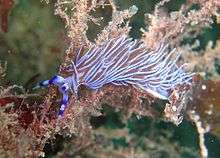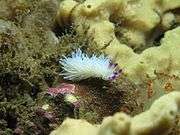Pteraeolidia ianthina
Pteraeolidia ianthina is a sea slug, an aeolid nudibranch in the family Facelinidae.[2][3] It is known as a blue dragon,[4] a name it shares with Glaucus atlanticus.
| Pteraeolidia ianthina | |
|---|---|
 | |
| Scientific classification | |
| Kingdom: | Animalia |
| Phylum: | Mollusca |
| Class: | Gastropoda |
| Subclass: | Heterobranchia |
| Order: | Nudibranchia |
| Infraorder: | Cladobranchia |
| Family: | Facelinidae |
| Genus: | Pteraeolidia |
| Species: | P. ianthina |
| Binomial name | |
| Pteraeolidia ianthina | |
| Synonyms | |
Distribution
This species is widespread throughout the Indo-Pacific.[5] Recent research shows that it is a complex of more than one species.[6]
Description
Pteraeolidia ianthina, one of the most common aeolids found, is often called a "blue dragon" by Eastern Australian divers because of its close resemblance to a Chinese dragon.[7] It is one of the most common aeolid nudibranchs found in Eastern Australia, and can inflict a painful sting to humans.
The body color of this species is translucent tan, but the cerata, which vary from dark purple to lavender to golden brown, give the nudibranch most of its distinct color. Green specimens are not uncommon.
The slug is elongated (7 cm (2.8 in)) with many clusters of medium-large sized cerata along the length of the body. The fat rhinophores and the long cephalic tentacles have at least two dark purple bands that stand out. The tips of the cerata contain nematocysts.
Algal zooxanthellae of the genus Symbiodinium derived from the food of these animals continue to photosynthesise inside the body and give rise to brown and green pigments. Symbiodinium, together with the nematocysts, are presumed to be derived from coelenterate prey. These Symbiodinium occur within vacuoles in host cells derived from the endoderm.[8]
Young specimens are much shorter, have fewer cerata, and are often mistaken for other nudibranch species.[3][9]
Symbiosis with dinoflagellates
This sea slug feeds on hydroids which contain Symbiodinium, microscopic dinoflagellates that are photosynthetic. The microscopic Symbiodinium acquired from the hydroids are 'farmed' in the sea slug's digestive diverticula, where the Symbiodinium photosynthesizes sugars to be used by the slug. The slug gains enough photosythetically derived sugars to sustain it without feeding.
References
- (in French) Angas G. F. (1864). "Description d'espèces nouvelles appartenant à plusieurs genres de Mollusques Nudibranches des environs de Port-Jackson (Nouvelle-Galles du Sud), accompagnée de dessins faits d'après nature". Journal de Conchyliologie, series 3, 12: 43-70, pls. 4-6. Description is the page 66-67. Plate 6, figure 6.
- Bouchet P. & Rocroi J.-P. (Ed.); Frýda J., Hausdorf B., Ponder W., Valdes A. & Warén A. 2005. Classification and nomenclator of gastropod families. Malacologia: International Journal of Malacology, 47(1-2). ConchBooks: Hackenheim, Germany. ISBN 3-925919-72-4. ISSN 0076-2997. 397 pp. http://www.vliz.be/Vmdcdata/imis2/ref.php?refid=78278
- Rosenberg, G. (2012). Pteraeolidia ianthina. Accessed through: World Register of Marine Species at http://www.marinespecies.org/aphia.php?p=taxdetails&id=213527 on 1 September 2012
- jurisdiction=New South Wales; corporateName=Australian Museum; author=Rudman, W. B. (15 July 2010). "The Sea Slug Forum - Pteraeolidia ianthina". www.seaslugforum.net. Retrieved 6 July 2019.CS1 maint: multiple names: authors list (link)
- Wilson, Nerida (18 August 2015). "Here be dragons - phylogeography of Pteraeolidia ianthina (Angas, 1864) reveals multiple species of photosynthetic nudibranchs (Aeolidina: Nudibranchia)". Zoological Journal of the Linnean Society. 175 (1): 119–133. doi:10.1111/zoj.12266. Retrieved 25 April 2019.
- Nerida G Wilson and Ingo Burghardt: Here be dragons – phylogeography of Pteraeolidia ianthina (Angas, 1864) reveals multiple species of photosynthetic nudibranchs (Aeolidina: Nudibranchia), in the ©2015 The Linnean Society of London,Zoological Journal of the Linnean Society, 2015,175, 119–133.doi: 10.1111/zoj.12266.
- http://www.philippine-seaslugs.com/AEOLIDINA/Pteraeolidia_ianthina.htm%5B%5D Pteraeolidia ianthina
- Sutton & Hoegh-Guldberg, Host-Zooxanthella Interactions in Four Temperate Marine Symbioses; Assessment of Effect of Host Extract on Symbionts; The Biological bulletin, Marine Biological Laboratory (Woods Hole, Mass.). v. 178 (1990) p. 175
- Cory Pittman and Pauline Fiene, 2015. Pteraeolidia semperi Sea slugs of Hawaii
Further reading
- Rudman, W. B. (1982). "The taxonomy and biology of further aeolidacean and arminacean nudibranch molluscs with symbiotic zooxanthellae. Zoological Journal of the Linnean Society 74(2):147-196.
- Yonow, N., R. Anderson C. & ButtressS. G. (2002). "Opisthobranch molluscs from the Chagos archipelago, central Indian Ocean". Journal of Natural History 36(7): 831-882.
- Richmond, M. (Ed.) (1997). A guide to the seashores of Eastern Africa and the Western Indian Ocean islands. Sida/Department for Research Cooperation, SAREC: Stockholm, Sweden. ISBN 91-630-4594-X. 448 pp. (
- Willan, R. (2009). Opisthobranchia (Mollusca). In: Gordon, D. (Ed.) (2009). New Zealand Inventory of Biodiversity. Volume One: Kingdom Animalia. 584 pp
- Wilson N.G. & Burghardt I. (2015). Here be dragons – phylogeography of Pteraeolidia ianthina (Angas, 1864) reveals multiple species of photosynthetic nudibranchs (Aeolidina: Nudibranchia). Zoological Journal of the Linnean Society. 175(1): 119-133
.jpg)
